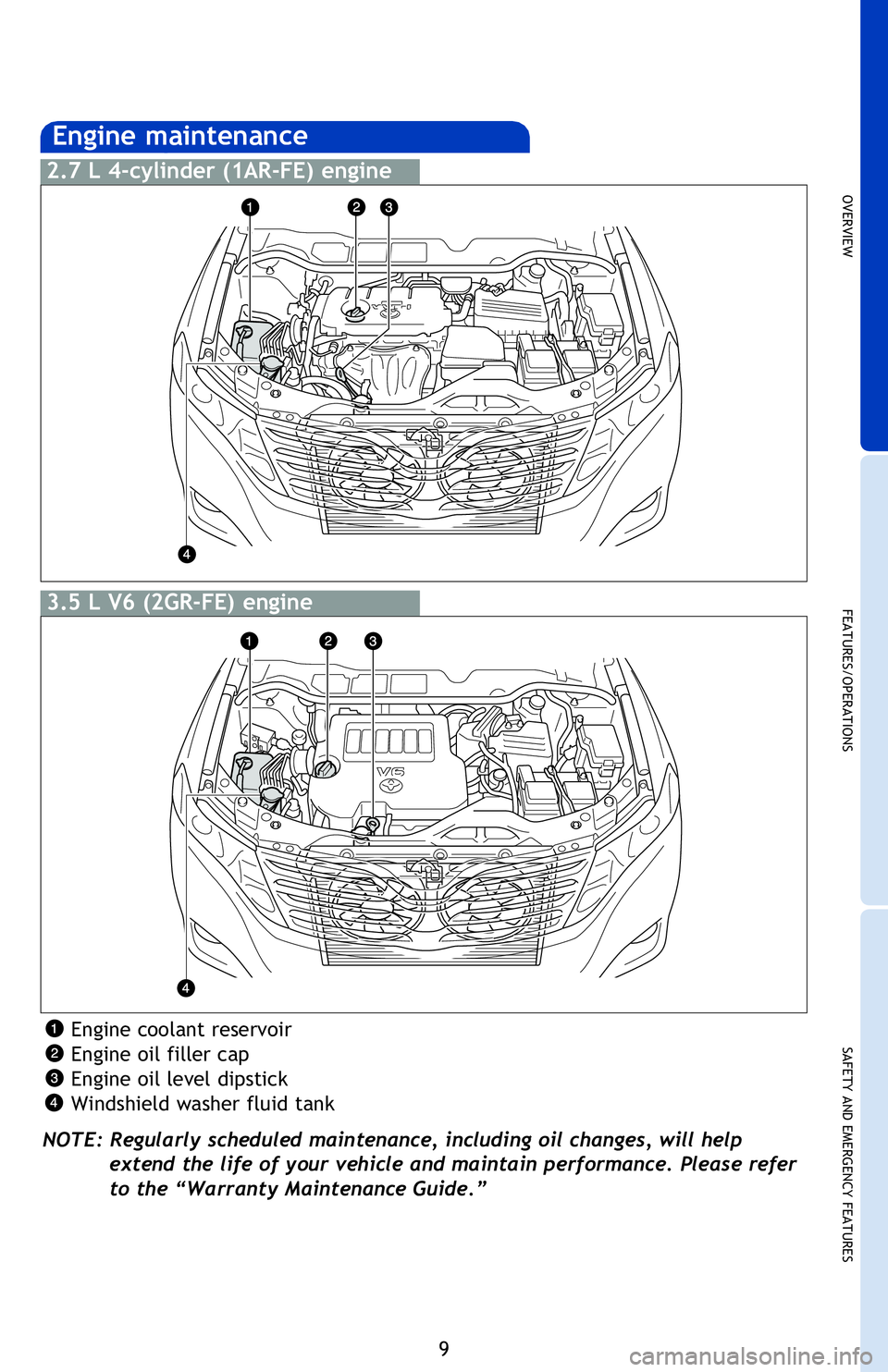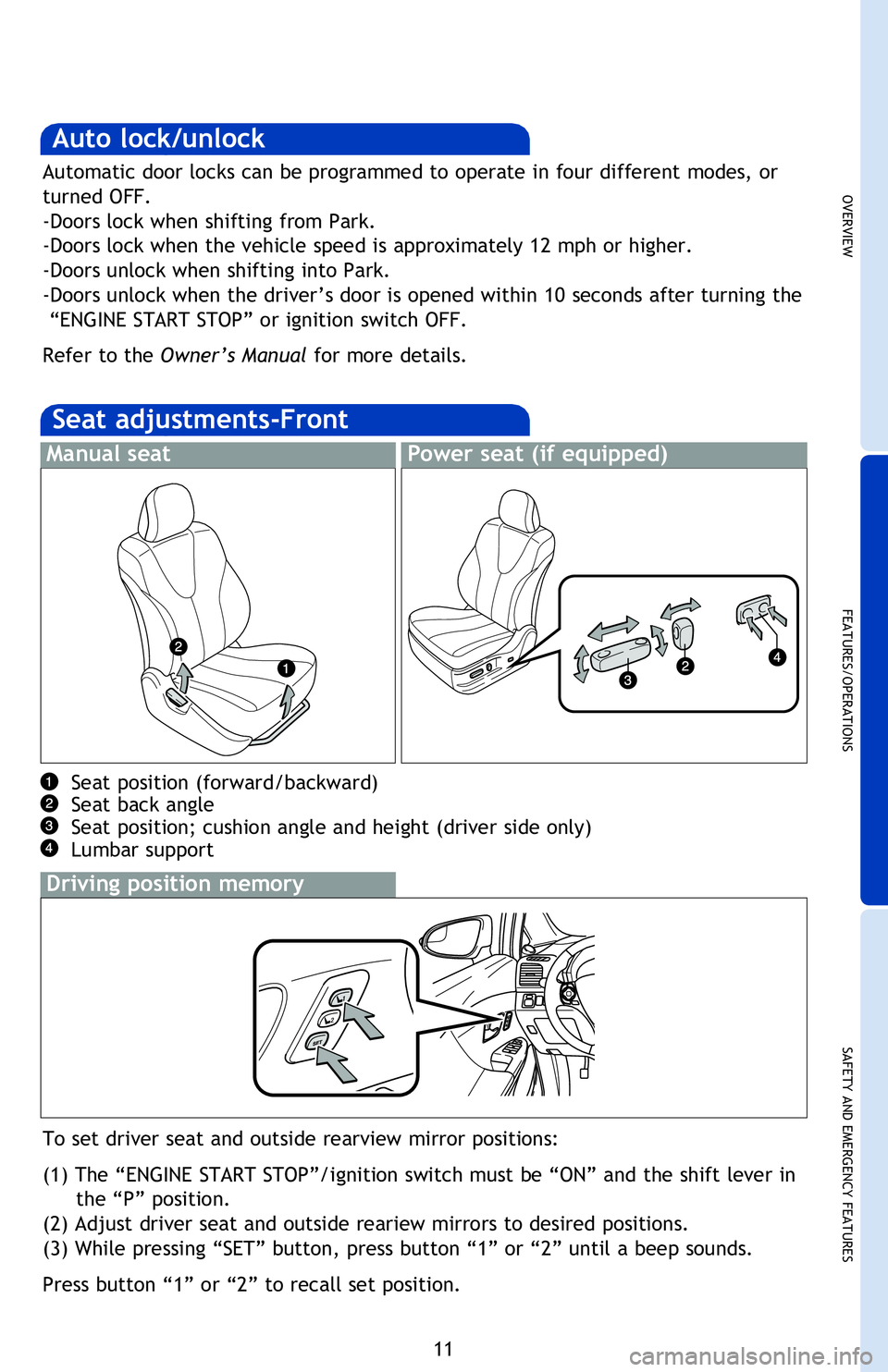2013 TOYOTA VENZA engine
[x] Cancel search: enginePage 11 of 32

OVERVIEW
FEATURES/OPERATIONS
SAFETY AND EMERGENCY FEATURES
9
NOTE: Tighten until one click is heard.
If the cap is not tightened enough,
Check Engine “
” indicator may
illuminate.
Engine coolant reservoir
Engine oil filler cap
Engine oil level dipstick
Windshield washer fluid tank
NOTE: Regularly scheduled maintenance, including oil changes, will help extend the life of your vehicle and maintain performance. Please refer
to the “Warranty Maintenance Guide.”
Engine maintenance
2.7 L 4-cylinder (1AR-FE) engine
3.5 L V6 (2GR-FE) engine
2013Venza.indd 95/10/12 8:34 PM
Page 12 of 32

10
FEATURES/OPERATIONS
Automatic Transmission
* The “ENGINE START STOP”/ignition switch must be “ON” and the brake pedal
depressed to shift from Park.
Shift the shift lever to “S” position from “D” position.
+ : Upshift (push and release)
- : Downshift (pull and release)
Downshifting increases power going uphill, or provides engine braking downhill.
For best fuel economy during normal driving conditions, always drive with the shift
lever in the “D” position.
“S” (Sequential) mode
Park*
Reverse
Neutral
Drive
“S” mode
“S”
“D”
Parking brake
Set: Depress
Release: Depress again
Seat adjustments-Front
Manual seat
Seat position (forward/backward)
Seat back angle
Seat position; cushion angle and height (driver side only)
Lumbar support
Driving position memory
To set driver seat and outside rearview mirror positions:
(1) The “ENGINE START STOP”/ignition switch must be “ON” and the shift lever in
the “P” position.
(2) Adjust driver seat and outside reariew mirrors to desired positions.
(3) While pressing “SET” button, press button “1” or “2” until a beep sounds.
Press button “1” or “2” to recall set position.
Auto lock/unlock
Automatic door locks can be programmed to operate in four different modes, or
turned OFF.
-Doors lock when shifting from Park.
-Doors lock when the vehicle speed is approximately 12 mph or higher.
-Doors unlock when shifting into Park.
-Doors unlock when the driver’s door is opened within 10 seconds after turning the
“ENGINE START STOP” or ignition switch OFF.
Refer to the Owner’s Manual for more details.
2013Venza.indd 105/10/12 8:34 PM
Page 13 of 32

OVERVIEW
FEATURES/OPERATIONS
SAFETY AND EMERGENCY FEATURES
11
* The “ENGINE START STOP”/ignition switch must be “ON” and the brake pedal
depressed to shift from Park.
Shift the shift lever to “S” position from “D” position.
+ : Upshift (push and release)
- : Downshift (pull and release)
Downshifting increases power going uphill, or provides engine braking downhill.
For best fuel economy during normal driving conditions, always drive with the shift
lever in the “D” position.
Set: Depress
Release: Depress again
Seat adjustments-Front
Manual seat
Seat position (forward/backward)
Seat back angle
Seat position; cushion angle and height (driver side only)
Lumbar support
Power seat (if equipped)
Driving position memory
To set driver seat and outside rearview mirror positions:
(1) The “ENGINE START STOP”/ignition switch must be “ON” and the shift lever in
the “P” position.
(2) Adjust driver seat and outside reariew mirrors to desired positions.
(3) While pressing “SET” button, press button “1” or “2” until a beep sounds.
Press button “1” or “2” to recall set position.
Auto lock/unlock
Automatic door locks can be programmed to operate in four different modes, or
turned OFF.
-Doors lock when shifting from Park.
-Doors lock when the vehicle speed is approximately 12 mph or higher.
-Doors unlock when shifting into Park.
-Doors unlock when the driver’s door is opened within 10 seconds after turning the
“ENGINE START STOP” or ignition switch OFF.
Refer to the Owner’s Manual for more details.
2013Venza.indd 115/10/12 8:34 PM
Page 18 of 32

16
FEATURES/OPERATIONS
Air Conditioning/Heating
Push: Automatic climate control ON
Adjusting the temperature setting will cause the airflow vents, air
intake and fan to adjust automatically.
Turn: Temperature selector (driver side)
Fan speed
Airflow vent
In “
” mode, use fresh air (“” indicator OFF) to reduce window
fogging. “
” mode uses fresh air only.
Push: Dual operation ON/OFF
Separate temperature setting or synchronize temperature setting for
driver and passenger.
Turn: Temperature selector (front passenger side)
Air Conditioning ON/OFF
Recirculate cabin air (fresh air when OFF)
Outside rearview mirror/Rear window defogger/Windshield wiper
de-icer
Windshield defogger
Climate control OFF
Seat heaters (if equipped)
Driver’s seatFront passenger’s seat
Turn
On
The Enhanced VSC OFF button is used to switch between modes related to the
TRAC and Enhanced VSC functions.
Refer to Section 2-4 of the Owner’s Manual for more information.
Enhanced VSC OFF button
Power outlets-12V DC
Instrument panel
NOTE: Designed for car accessories. The “ENGINE START STOP”/ignition switch must
be in the ACCESSORY or ON position to be used.
2013Venza.indd 165/10/12 8:35 PM
Page 19 of 32

OVERVIEW
FEATURES/OPERATIONS
SAFETY AND EMERGENCY FEATURES
17
Push: Automatic climate control ON
Adjusting the temperature setting will cause the airflow vents, air
intake and fan to adjust automatically.
Turn: Temperature selector (driver side)
Fan speed
Airflow vent
In “
” mode, use fresh air (“” indicator OFF) to reduce window
fogging. “
” mode uses fresh air only.
Push: Dual operation ON/OFF
Separate temperature setting or synchronize temperature setting for
driver and passenger.
Turn: Temperature selector (front passenger side)
Air Conditioning ON/OFF
Recirculate cabin air (fresh air when OFF)
Outside rearview mirror/Rear window defogger/Windshield wiper
de-icer
Windshield defogger
Climate control OFF
Front passenger’s seat
The Enhanced VSC OFF button is used to switch between modes related to the
TRAC and Enhanced VSC functions.
Refer to Section 2-4 of the Owner’s Manual for more information.
Enhanced VSC
OFF button
Enhanced VSC OFF button
Power outlets-12V DC
Instrument panelInside center console
NOTE: Designed for car accessories. The “ENGINE START STOP”/ignition switch must
be in the ACCESSORY or ON position to be used.
Luggage compartment
2013Venza.indd 175/10/12 8:35 PM
Page 28 of 32

26
Star Safety SystemTM
VSC helps prevent loss of traction during cornering by reducing engine power and
applying brake force to selected wheels.
Toyota’s VSC monitors steering angle and the direction your vehicle is traveling.
When it senses that the front or rear wheels begin to lose traction, VSC reduces
engine power and applies braking to selected wheels. This helps restore traction
and vehicle control.
Vehicle Stability Control (VSC)
Anti-Lock Brake System (ABS)
ABS helps prevent brakes from locking up by “pulsing” brake pressure to each
wheel. This limits brake lockup and helps provide directional control for the
current road conditions.
Toyota’s ABS sensors detect which wheels are locking up and limits wheel lockup
by “pulsing” each wheel’s brakes independently. Pulsing releases brake pressure
repeatedly for fractions of a second. This helps the tires attain the traction that
current road conditions will allow, helping you to stay in directional control.
Brake Assist (BA)
Brake Assist is designed to detect sudden or “panic” braking, and then add braking
pressure to help decrease the vehicle’s stopping distance. When there’s only a
split second to react, Brake Assist can add additional brake pressure more quickly
than just the driver alone can. VSC helps prevent loss of traction during cornering by reducing engine power, and
Traction Control helps maintain traction on loose gravel and wet, icy, or uneven
surfaces by applying brake force to the spinning wheel(s).
Toyota’s TRAC sensors are activated when one of the drive wheels starts to slip.
TRAC limits engine output and applies the brakes to the spinning wheel. This
transfers power to the wheels that still have traction to help keep you on track.
Traction Control (TRAC)
Electronic Brake Force Distribution (EBD)
Toyota’s ABS technology has Electronic Brake-force Distribution (EBD) to help
maintain control and balance when braking. Abrupt stops can cause a vehicle
to tilt forward, reducing the braking power of the rear wheels. EBD responds to
sudden stops by redistributing brake force to enhance the braking effectiveness of
all four wheels.
SAFETY AND EMERGENCY FEATURES
All new Toyota vehicles come standard with the Star Safety SystemTM, which
combines Vehicle Stability Control (VSC), Traction Control (TRAC), Anti-lock
Braking System (ABS), Electronic Brake-force Distribution (EBD), Brake Assist (BA)
and Smart Stop Technology (SST).
There are two types of Toyota floor mats: carpeted and all-weather. Each vehicle
has model-specific floor mats. Installation is easy.
To keep your floor mat properly positioned, follow these steps:
• Only use floor mats designed for your specific model.
• Use only one floor mat at a time, using the retaining hooks to keep the mat in
place.
• Install floor mats right side up.
Floor mat installation
Smart Stop Technology automatically reduces engine power when the accelerator
and brake pedals are pressed simultaneously under certain conditions.
SST engages when the accelerator is depressed first and the brakes are applied
firmly for longer than one-half second at speeds greater than five miles per hour.
SST doesn’t engage if the brake pedal is depressed before the accelerator pedal,
allowing vehicles to start on a steep hill and safely accelerate without rolling
backward.
Smart Stop Technology (SST)
2013Venza.indd 265/10/12 8:38 PM
Page 29 of 32

OVERVIEW
FEATURES/OPERATIONS
SAFETY AND EMERGENCY FEATURES
27
VSC helps prevent loss of traction during cornering by reducing engine power and
applying brake force to selected wheels.
Toyota’s VSC monitors steering angle and the direction your vehicle is traveling.
When it senses that the front or rear wheels begin to lose traction, VSC reduces
engine power and applies braking to selected wheels. This helps restore traction
and vehicle control.
ABS helps prevent brakes from locking up by “pulsing” brake pressure to each
wheel. This limits brake lockup and helps provide directional control for the
current road conditions.
Toyota’s ABS sensors detect which wheels are locking up and limits wheel lockup
by “pulsing” each wheel’s brakes independently. Pulsing releases brake pressure
repeatedly for fractions of a second. This helps the tires attain the traction that
current road conditions will allow, helping you to stay in directional control.
Brake Assist is designed to detect sudden or “panic” braking, and then add braking
pressure to help decrease the vehicle’s stopping distance. When there’s only a
split second to react, Brake Assist can add additional brake pressure more quickly
than just the driver alone can. VSC helps prevent loss of traction during cornering by reducing engine power, and
Traction Control helps maintain traction on loose gravel and wet, icy, or uneven
surfaces by applying brake force to the spinning wheel(s).
Toyota’s TRAC sensors are activated when one of the drive wheels starts to slip.
TRAC limits engine output and applies the brakes to the spinning wheel. This
transfers power to the wheels that still have traction to help keep you on track.
Toyota’s ABS technology has Electronic Brake-force Distribution (EBD) to help
maintain control and balance when braking. Abrupt stops can cause a vehicle
to tilt forward, reducing the braking power of the rear wheels. EBD responds to
sudden stops by redistributing brake force to enhance the braking effectiveness of
all four wheels.
SAFETY AND EMERGENCY FEATURES
All new Toyota vehicles come standard with the Star Safety SystemTM, which
combines Vehicle Stability Control (VSC), Traction Control (TRAC), Anti-lock
Braking System (ABS), Electronic Brake-force Distribution (EBD), Brake Assist (BA)
and Smart Stop Technology (SST).
There are two types of Toyota floor mats: carpeted and all-weather. Each vehicle
has model-specific floor mats. Installation is easy.
To keep your floor mat properly positioned, follow these steps:
• Only use floor mats designed for your specific model.
• Use only one floor mat at a time, using the retaining hooks to keep the mat in
place.
• Install floor mats right side up.
Floor mat installation
Smart Stop Technology automatically reduces engine power when the accelerator
and brake pedals are pressed simultaneously under certain conditions.
SST engages when the accelerator is depressed first and the brakes are applied
firmly for longer than one-half second at speeds greater than five miles per hour.
SST doesn’t engage if the brake pedal is depressed before the accelerator pedal,
allowing vehicles to start on a steep hill and safely accelerate without rolling
backward.
Smart Stop Technology (SST)
2013Venza.indd 275/10/12 8:38 PM